Leadership & Management: Examining Theories, Skills & Competencies
VerifiedAdded on 2023/04/07
|13
|2554
|114
Essay
AI Summary
This essay provides a comprehensive overview of leadership and management theories, focusing on the trait theory, contingency theory, and behavioral theory. It discusses essential leadership competencies and skills, such as communication, integrity, openness to experience, creativity, trust, and flexibility. The essay also examines the application of different leadership styles in organizations, highlighting the importance of adapting to situational factors and employee characteristics. Furthermore, it analyzes leadership competencies required for success in PepsiCo Foods Mexico (PFM), emphasizing passion, team management, innovation, and the integration of various leadership theories to achieve organizational goals. This resource is available on Desklib, where students can find a wide array of solved assignments and study materials.
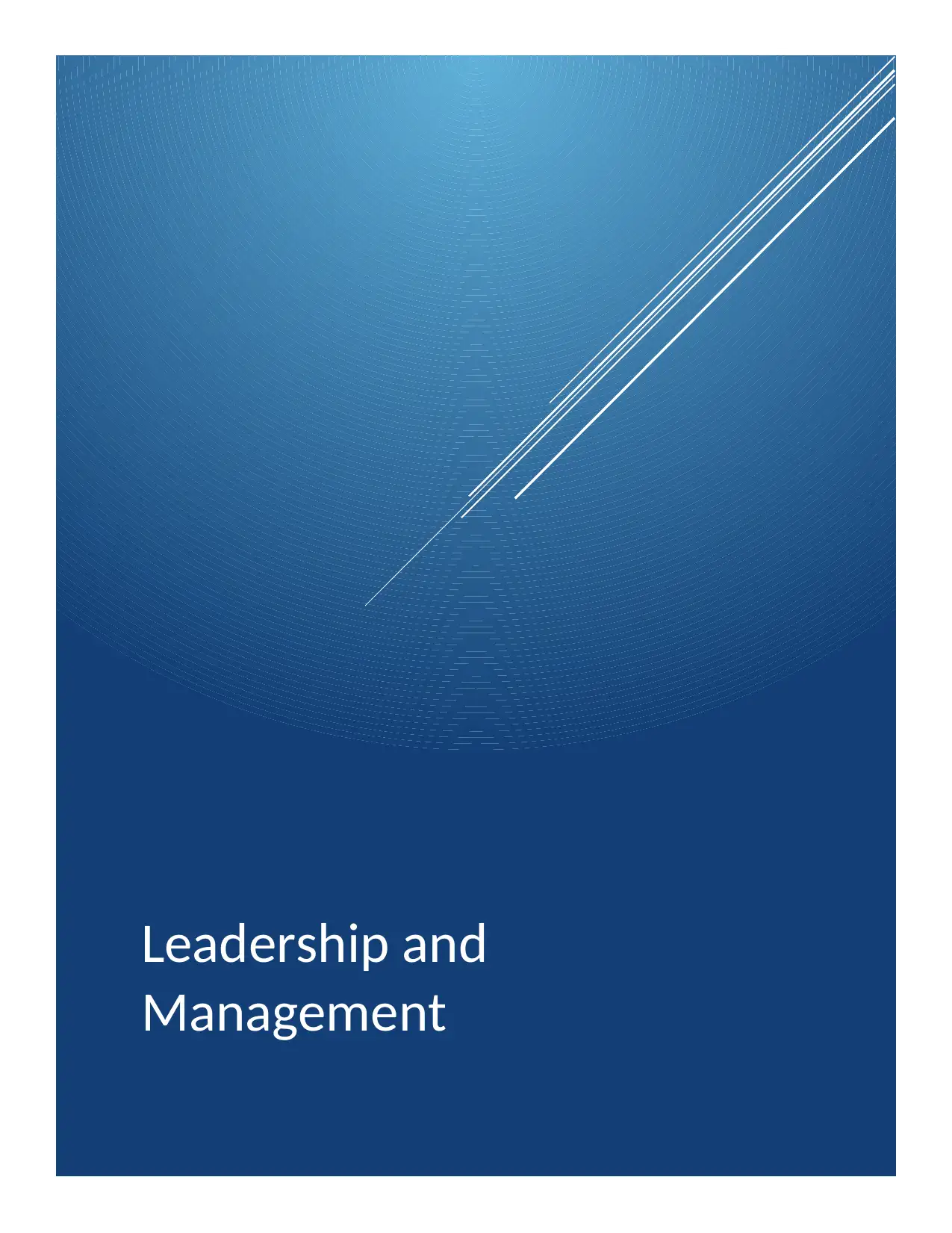
Leadership and
Management
Management
Paraphrase This Document
Need a fresh take? Get an instant paraphrase of this document with our AI Paraphraser
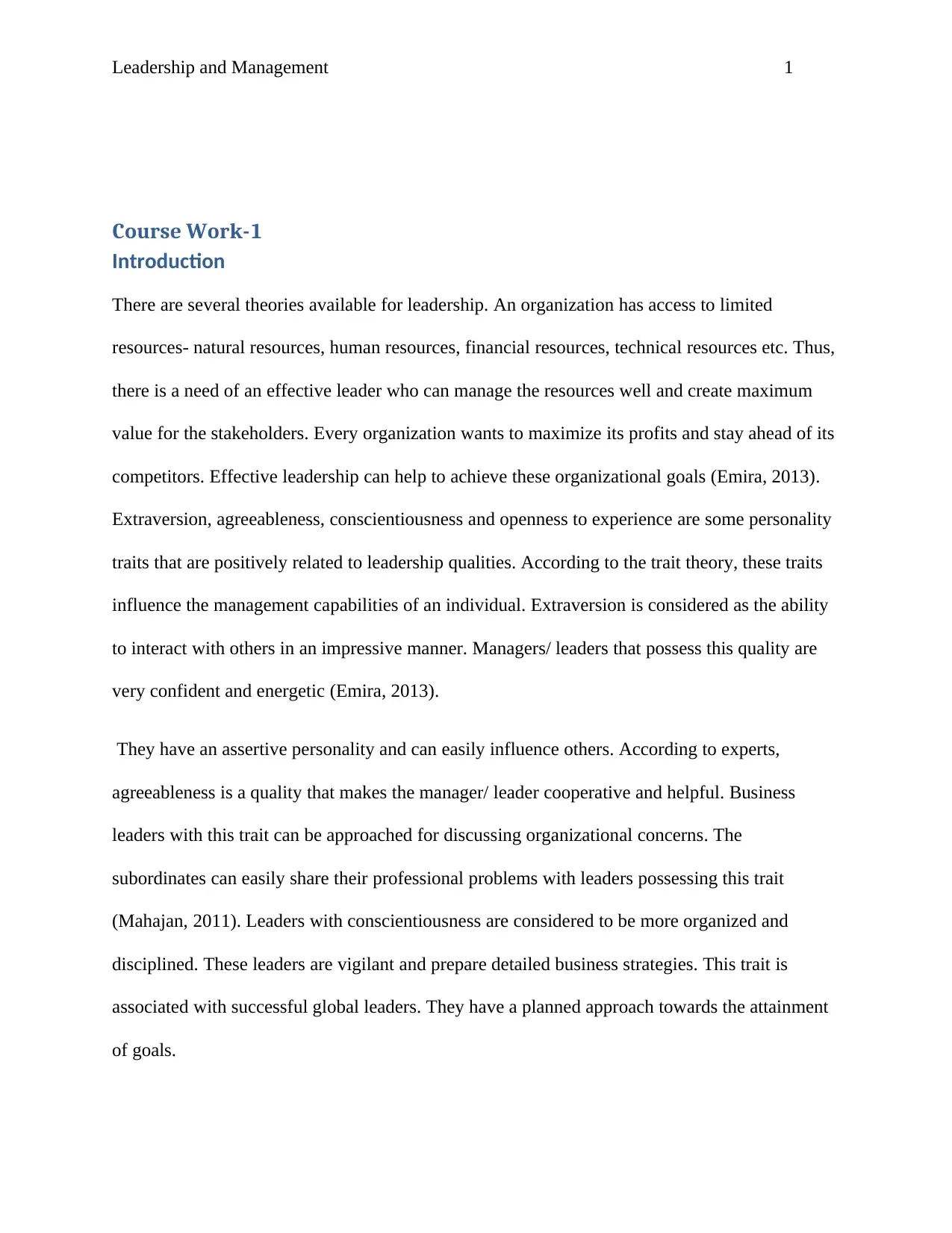
Leadership and Management 1
Course Work-1
Introduction
There are several theories available for leadership. An organization has access to limited
resources- natural resources, human resources, financial resources, technical resources etc. Thus,
there is a need of an effective leader who can manage the resources well and create maximum
value for the stakeholders. Every organization wants to maximize its profits and stay ahead of its
competitors. Effective leadership can help to achieve these organizational goals (Emira, 2013).
Extraversion, agreeableness, conscientiousness and openness to experience are some personality
traits that are positively related to leadership qualities. According to the trait theory, these traits
influence the management capabilities of an individual. Extraversion is considered as the ability
to interact with others in an impressive manner. Managers/ leaders that possess this quality are
very confident and energetic (Emira, 2013).
They have an assertive personality and can easily influence others. According to experts,
agreeableness is a quality that makes the manager/ leader cooperative and helpful. Business
leaders with this trait can be approached for discussing organizational concerns. The
subordinates can easily share their professional problems with leaders possessing this trait
(Mahajan, 2011). Leaders with conscientiousness are considered to be more organized and
disciplined. These leaders are vigilant and prepare detailed business strategies. This trait is
associated with successful global leaders. They have a planned approach towards the attainment
of goals.
Course Work-1
Introduction
There are several theories available for leadership. An organization has access to limited
resources- natural resources, human resources, financial resources, technical resources etc. Thus,
there is a need of an effective leader who can manage the resources well and create maximum
value for the stakeholders. Every organization wants to maximize its profits and stay ahead of its
competitors. Effective leadership can help to achieve these organizational goals (Emira, 2013).
Extraversion, agreeableness, conscientiousness and openness to experience are some personality
traits that are positively related to leadership qualities. According to the trait theory, these traits
influence the management capabilities of an individual. Extraversion is considered as the ability
to interact with others in an impressive manner. Managers/ leaders that possess this quality are
very confident and energetic (Emira, 2013).
They have an assertive personality and can easily influence others. According to experts,
agreeableness is a quality that makes the manager/ leader cooperative and helpful. Business
leaders with this trait can be approached for discussing organizational concerns. The
subordinates can easily share their professional problems with leaders possessing this trait
(Mahajan, 2011). Leaders with conscientiousness are considered to be more organized and
disciplined. These leaders are vigilant and prepare detailed business strategies. This trait is
associated with successful global leaders. They have a planned approach towards the attainment
of goals.
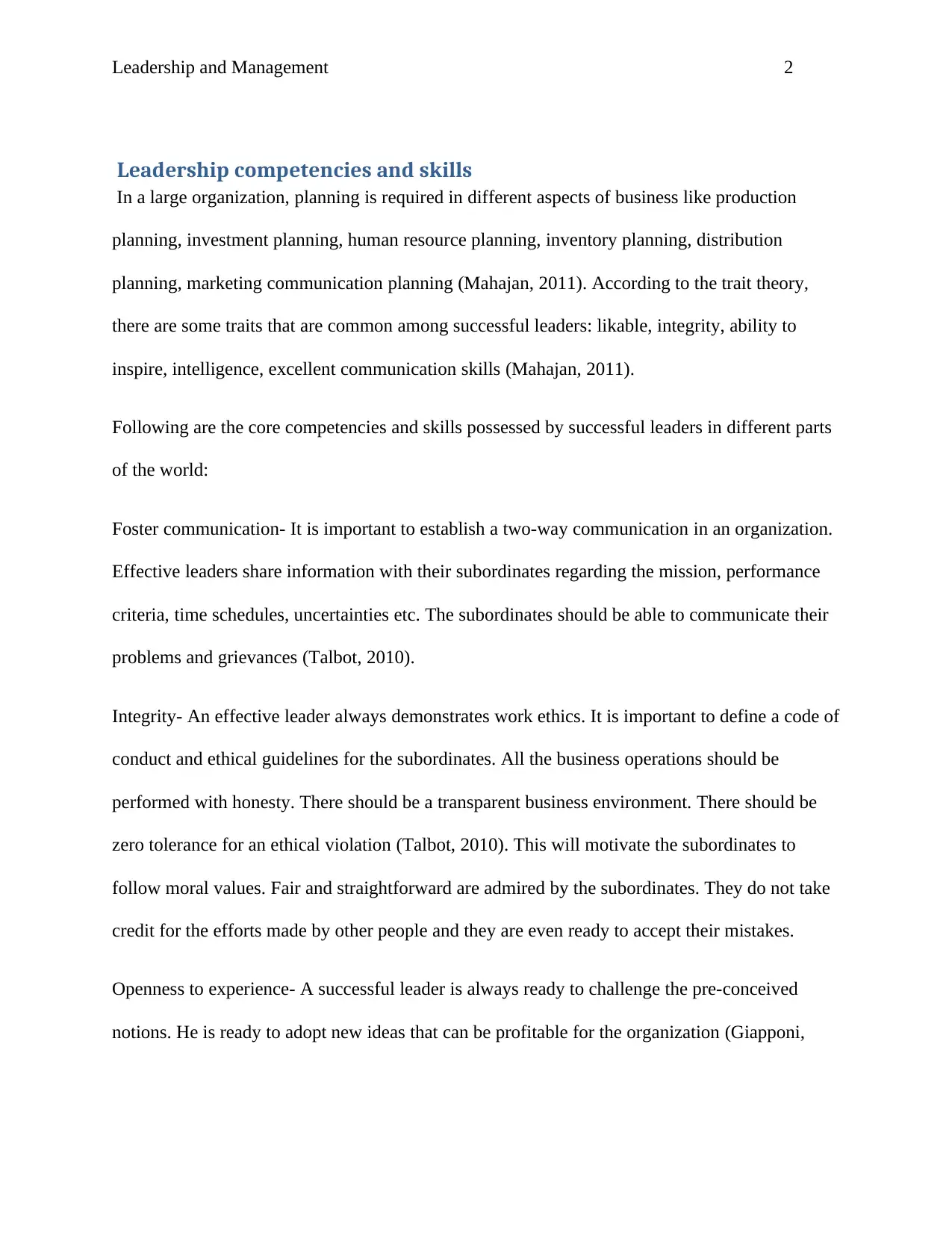
Leadership and Management 2
Leadership competencies and skills
In a large organization, planning is required in different aspects of business like production
planning, investment planning, human resource planning, inventory planning, distribution
planning, marketing communication planning (Mahajan, 2011). According to the trait theory,
there are some traits that are common among successful leaders: likable, integrity, ability to
inspire, intelligence, excellent communication skills (Mahajan, 2011).
Following are the core competencies and skills possessed by successful leaders in different parts
of the world:
Foster communication- It is important to establish a two-way communication in an organization.
Effective leaders share information with their subordinates regarding the mission, performance
criteria, time schedules, uncertainties etc. The subordinates should be able to communicate their
problems and grievances (Talbot, 2010).
Integrity- An effective leader always demonstrates work ethics. It is important to define a code of
conduct and ethical guidelines for the subordinates. All the business operations should be
performed with honesty. There should be a transparent business environment. There should be
zero tolerance for an ethical violation (Talbot, 2010). This will motivate the subordinates to
follow moral values. Fair and straightforward are admired by the subordinates. They do not take
credit for the efforts made by other people and they are even ready to accept their mistakes.
Openness to experience- A successful leader is always ready to challenge the pre-conceived
notions. He is ready to adopt new ideas that can be profitable for the organization (Giapponi,
Leadership competencies and skills
In a large organization, planning is required in different aspects of business like production
planning, investment planning, human resource planning, inventory planning, distribution
planning, marketing communication planning (Mahajan, 2011). According to the trait theory,
there are some traits that are common among successful leaders: likable, integrity, ability to
inspire, intelligence, excellent communication skills (Mahajan, 2011).
Following are the core competencies and skills possessed by successful leaders in different parts
of the world:
Foster communication- It is important to establish a two-way communication in an organization.
Effective leaders share information with their subordinates regarding the mission, performance
criteria, time schedules, uncertainties etc. The subordinates should be able to communicate their
problems and grievances (Talbot, 2010).
Integrity- An effective leader always demonstrates work ethics. It is important to define a code of
conduct and ethical guidelines for the subordinates. All the business operations should be
performed with honesty. There should be a transparent business environment. There should be
zero tolerance for an ethical violation (Talbot, 2010). This will motivate the subordinates to
follow moral values. Fair and straightforward are admired by the subordinates. They do not take
credit for the efforts made by other people and they are even ready to accept their mistakes.
Openness to experience- A successful leader is always ready to challenge the pre-conceived
notions. He is ready to adopt new ideas that can be profitable for the organization (Giapponi,
⊘ This is a preview!⊘
Do you want full access?
Subscribe today to unlock all pages.

Trusted by 1+ million students worldwide
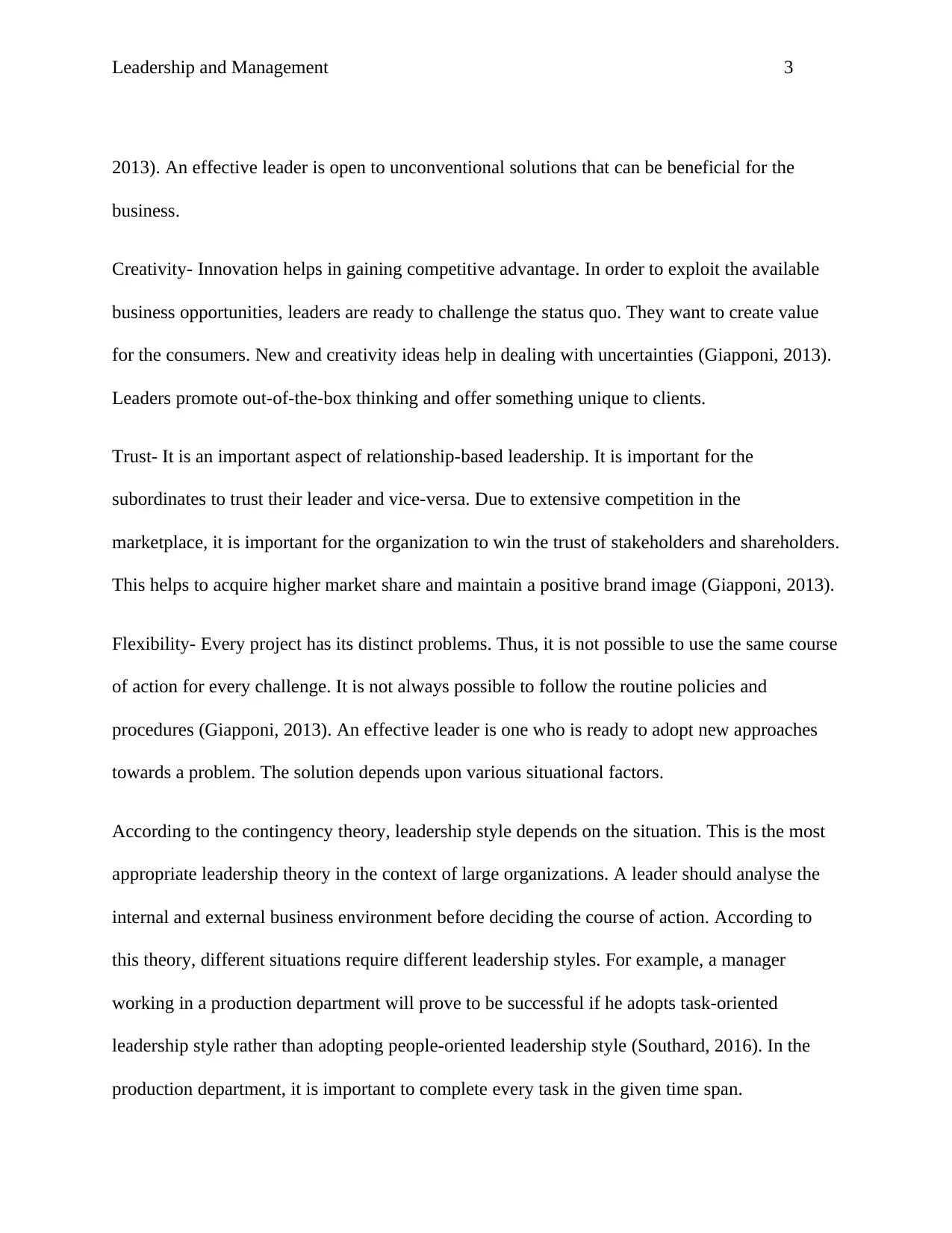
Leadership and Management 3
2013). An effective leader is open to unconventional solutions that can be beneficial for the
business.
Creativity- Innovation helps in gaining competitive advantage. In order to exploit the available
business opportunities, leaders are ready to challenge the status quo. They want to create value
for the consumers. New and creativity ideas help in dealing with uncertainties (Giapponi, 2013).
Leaders promote out-of-the-box thinking and offer something unique to clients.
Trust- It is an important aspect of relationship-based leadership. It is important for the
subordinates to trust their leader and vice-versa. Due to extensive competition in the
marketplace, it is important for the organization to win the trust of stakeholders and shareholders.
This helps to acquire higher market share and maintain a positive brand image (Giapponi, 2013).
Flexibility- Every project has its distinct problems. Thus, it is not possible to use the same course
of action for every challenge. It is not always possible to follow the routine policies and
procedures (Giapponi, 2013). An effective leader is one who is ready to adopt new approaches
towards a problem. The solution depends upon various situational factors.
According to the contingency theory, leadership style depends on the situation. This is the most
appropriate leadership theory in the context of large organizations. A leader should analyse the
internal and external business environment before deciding the course of action. According to
this theory, different situations require different leadership styles. For example, a manager
working in a production department will prove to be successful if he adopts task-oriented
leadership style rather than adopting people-oriented leadership style (Southard, 2016). In the
production department, it is important to complete every task in the given time span.
2013). An effective leader is open to unconventional solutions that can be beneficial for the
business.
Creativity- Innovation helps in gaining competitive advantage. In order to exploit the available
business opportunities, leaders are ready to challenge the status quo. They want to create value
for the consumers. New and creativity ideas help in dealing with uncertainties (Giapponi, 2013).
Leaders promote out-of-the-box thinking and offer something unique to clients.
Trust- It is an important aspect of relationship-based leadership. It is important for the
subordinates to trust their leader and vice-versa. Due to extensive competition in the
marketplace, it is important for the organization to win the trust of stakeholders and shareholders.
This helps to acquire higher market share and maintain a positive brand image (Giapponi, 2013).
Flexibility- Every project has its distinct problems. Thus, it is not possible to use the same course
of action for every challenge. It is not always possible to follow the routine policies and
procedures (Giapponi, 2013). An effective leader is one who is ready to adopt new approaches
towards a problem. The solution depends upon various situational factors.
According to the contingency theory, leadership style depends on the situation. This is the most
appropriate leadership theory in the context of large organizations. A leader should analyse the
internal and external business environment before deciding the course of action. According to
this theory, different situations require different leadership styles. For example, a manager
working in a production department will prove to be successful if he adopts task-oriented
leadership style rather than adopting people-oriented leadership style (Southard, 2016). In the
production department, it is important to complete every task in the given time span.
Paraphrase This Document
Need a fresh take? Get an instant paraphrase of this document with our AI Paraphraser
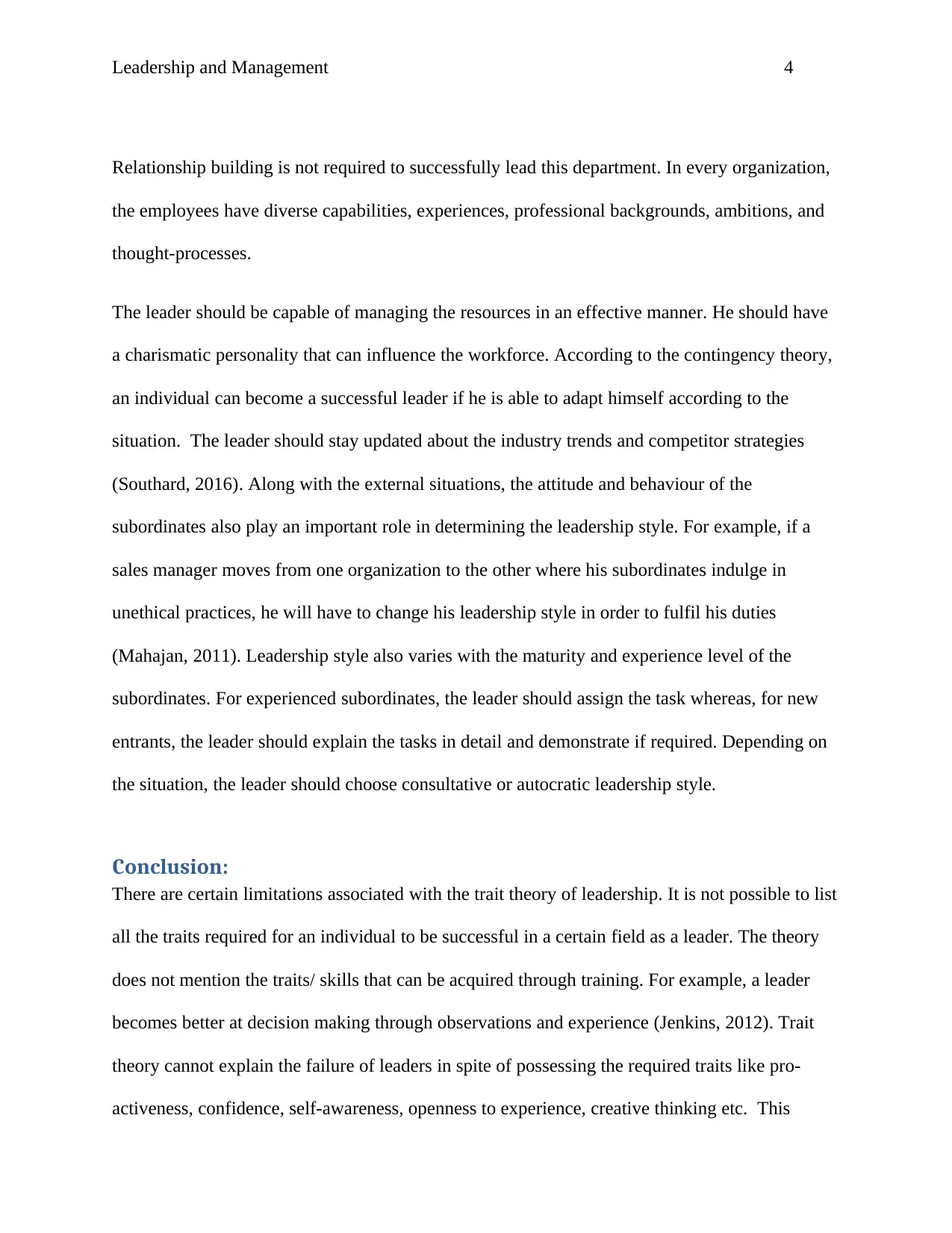
Leadership and Management 4
Relationship building is not required to successfully lead this department. In every organization,
the employees have diverse capabilities, experiences, professional backgrounds, ambitions, and
thought-processes.
The leader should be capable of managing the resources in an effective manner. He should have
a charismatic personality that can influence the workforce. According to the contingency theory,
an individual can become a successful leader if he is able to adapt himself according to the
situation. The leader should stay updated about the industry trends and competitor strategies
(Southard, 2016). Along with the external situations, the attitude and behaviour of the
subordinates also play an important role in determining the leadership style. For example, if a
sales manager moves from one organization to the other where his subordinates indulge in
unethical practices, he will have to change his leadership style in order to fulfil his duties
(Mahajan, 2011). Leadership style also varies with the maturity and experience level of the
subordinates. For experienced subordinates, the leader should assign the task whereas, for new
entrants, the leader should explain the tasks in detail and demonstrate if required. Depending on
the situation, the leader should choose consultative or autocratic leadership style.
Conclusion:
There are certain limitations associated with the trait theory of leadership. It is not possible to list
all the traits required for an individual to be successful in a certain field as a leader. The theory
does not mention the traits/ skills that can be acquired through training. For example, a leader
becomes better at decision making through observations and experience (Jenkins, 2012). Trait
theory cannot explain the failure of leaders in spite of possessing the required traits like pro-
activeness, confidence, self-awareness, openness to experience, creative thinking etc. This
Relationship building is not required to successfully lead this department. In every organization,
the employees have diverse capabilities, experiences, professional backgrounds, ambitions, and
thought-processes.
The leader should be capable of managing the resources in an effective manner. He should have
a charismatic personality that can influence the workforce. According to the contingency theory,
an individual can become a successful leader if he is able to adapt himself according to the
situation. The leader should stay updated about the industry trends and competitor strategies
(Southard, 2016). Along with the external situations, the attitude and behaviour of the
subordinates also play an important role in determining the leadership style. For example, if a
sales manager moves from one organization to the other where his subordinates indulge in
unethical practices, he will have to change his leadership style in order to fulfil his duties
(Mahajan, 2011). Leadership style also varies with the maturity and experience level of the
subordinates. For experienced subordinates, the leader should assign the task whereas, for new
entrants, the leader should explain the tasks in detail and demonstrate if required. Depending on
the situation, the leader should choose consultative or autocratic leadership style.
Conclusion:
There are certain limitations associated with the trait theory of leadership. It is not possible to list
all the traits required for an individual to be successful in a certain field as a leader. The theory
does not mention the traits/ skills that can be acquired through training. For example, a leader
becomes better at decision making through observations and experience (Jenkins, 2012). Trait
theory cannot explain the failure of leaders in spite of possessing the required traits like pro-
activeness, confidence, self-awareness, openness to experience, creative thinking etc. This
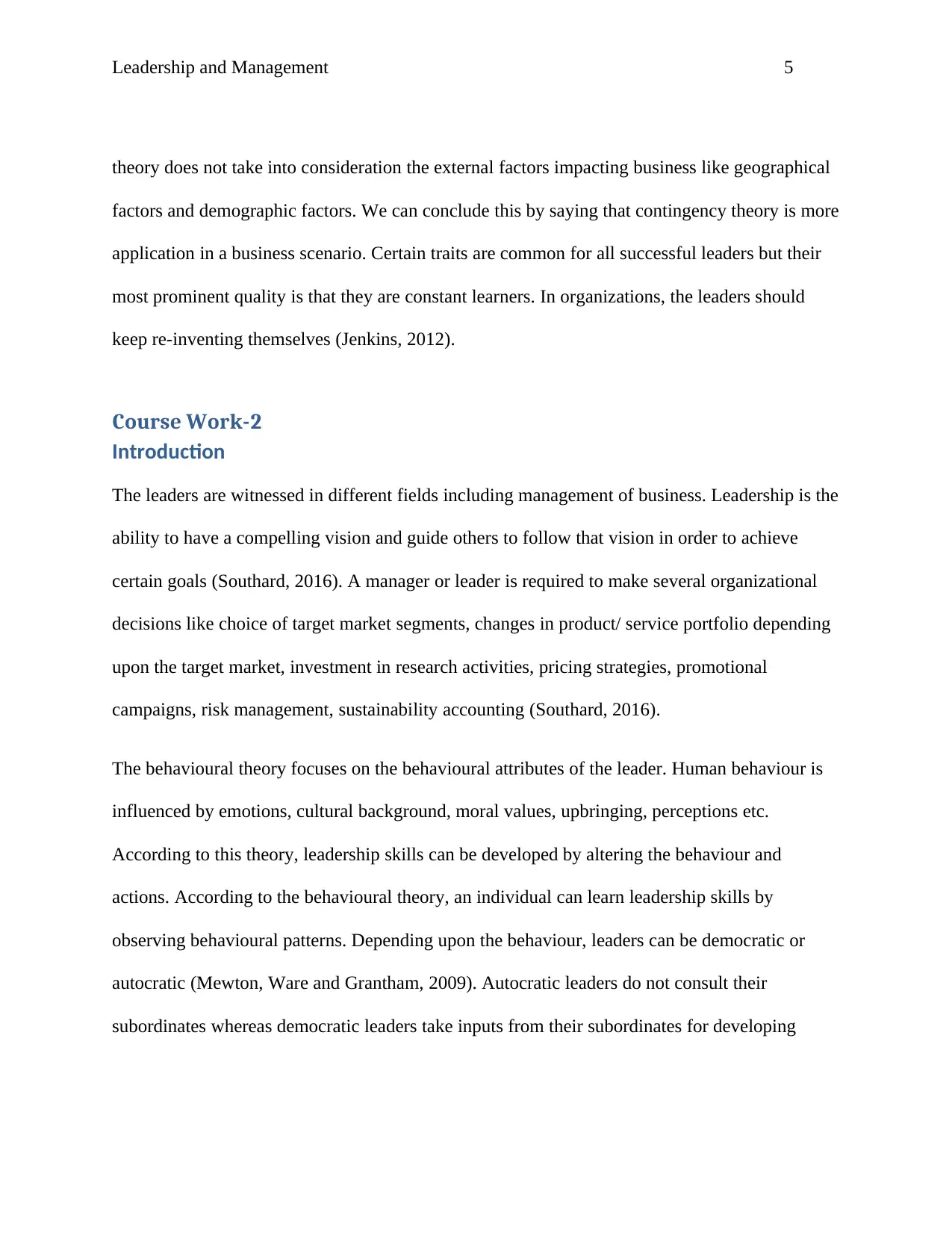
Leadership and Management 5
theory does not take into consideration the external factors impacting business like geographical
factors and demographic factors. We can conclude this by saying that contingency theory is more
application in a business scenario. Certain traits are common for all successful leaders but their
most prominent quality is that they are constant learners. In organizations, the leaders should
keep re-inventing themselves (Jenkins, 2012).
Course Work-2
Introduction
The leaders are witnessed in different fields including management of business. Leadership is the
ability to have a compelling vision and guide others to follow that vision in order to achieve
certain goals (Southard, 2016). A manager or leader is required to make several organizational
decisions like choice of target market segments, changes in product/ service portfolio depending
upon the target market, investment in research activities, pricing strategies, promotional
campaigns, risk management, sustainability accounting (Southard, 2016).
The behavioural theory focuses on the behavioural attributes of the leader. Human behaviour is
influenced by emotions, cultural background, moral values, upbringing, perceptions etc.
According to this theory, leadership skills can be developed by altering the behaviour and
actions. According to the behavioural theory, an individual can learn leadership skills by
observing behavioural patterns. Depending upon the behaviour, leaders can be democratic or
autocratic (Mewton, Ware and Grantham, 2009). Autocratic leaders do not consult their
subordinates whereas democratic leaders take inputs from their subordinates for developing
theory does not take into consideration the external factors impacting business like geographical
factors and demographic factors. We can conclude this by saying that contingency theory is more
application in a business scenario. Certain traits are common for all successful leaders but their
most prominent quality is that they are constant learners. In organizations, the leaders should
keep re-inventing themselves (Jenkins, 2012).
Course Work-2
Introduction
The leaders are witnessed in different fields including management of business. Leadership is the
ability to have a compelling vision and guide others to follow that vision in order to achieve
certain goals (Southard, 2016). A manager or leader is required to make several organizational
decisions like choice of target market segments, changes in product/ service portfolio depending
upon the target market, investment in research activities, pricing strategies, promotional
campaigns, risk management, sustainability accounting (Southard, 2016).
The behavioural theory focuses on the behavioural attributes of the leader. Human behaviour is
influenced by emotions, cultural background, moral values, upbringing, perceptions etc.
According to this theory, leadership skills can be developed by altering the behaviour and
actions. According to the behavioural theory, an individual can learn leadership skills by
observing behavioural patterns. Depending upon the behaviour, leaders can be democratic or
autocratic (Mewton, Ware and Grantham, 2009). Autocratic leaders do not consult their
subordinates whereas democratic leaders take inputs from their subordinates for developing
⊘ This is a preview!⊘
Do you want full access?
Subscribe today to unlock all pages.

Trusted by 1+ million students worldwide
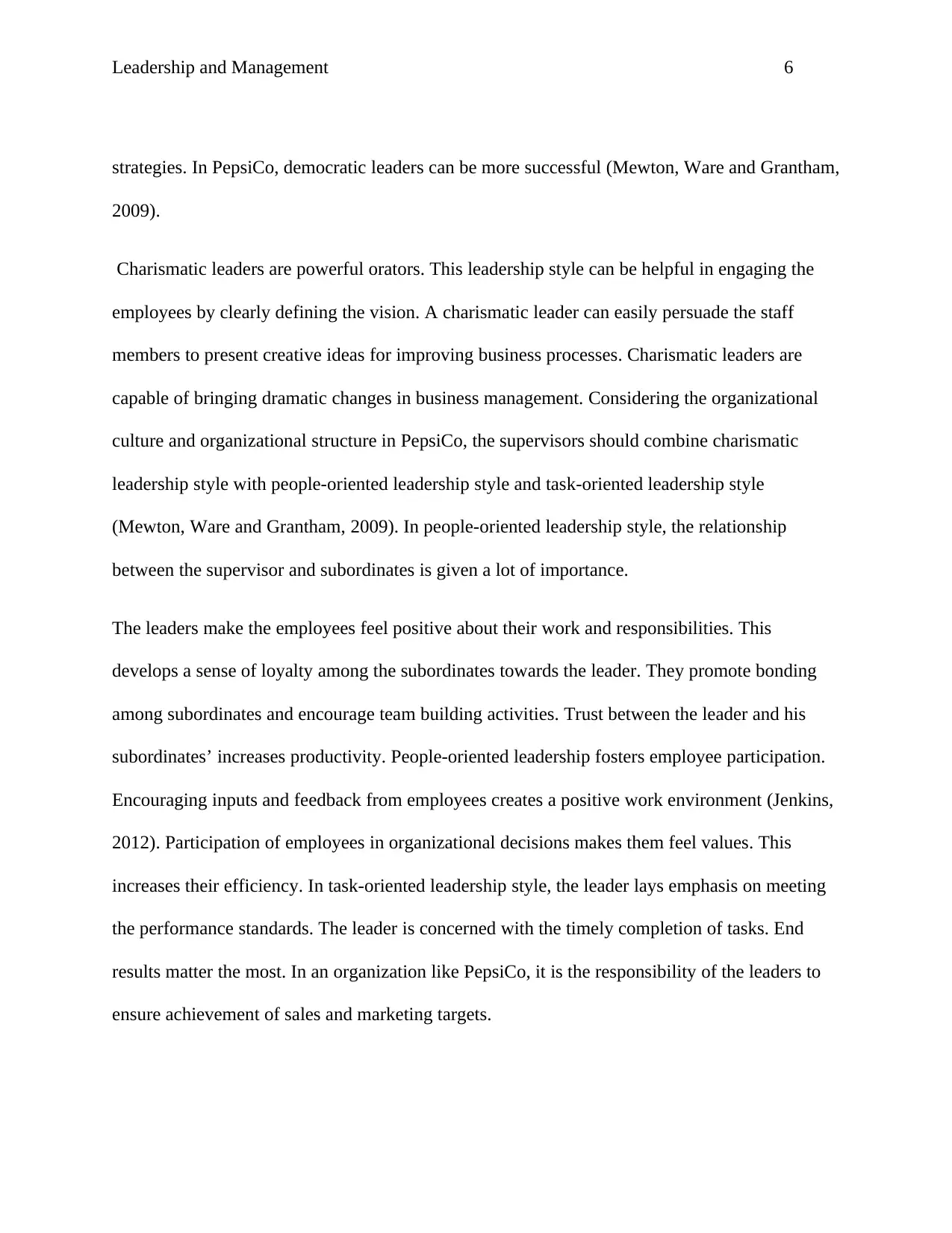
Leadership and Management 6
strategies. In PepsiCo, democratic leaders can be more successful (Mewton, Ware and Grantham,
2009).
Charismatic leaders are powerful orators. This leadership style can be helpful in engaging the
employees by clearly defining the vision. A charismatic leader can easily persuade the staff
members to present creative ideas for improving business processes. Charismatic leaders are
capable of bringing dramatic changes in business management. Considering the organizational
culture and organizational structure in PepsiCo, the supervisors should combine charismatic
leadership style with people-oriented leadership style and task-oriented leadership style
(Mewton, Ware and Grantham, 2009). In people-oriented leadership style, the relationship
between the supervisor and subordinates is given a lot of importance.
The leaders make the employees feel positive about their work and responsibilities. This
develops a sense of loyalty among the subordinates towards the leader. They promote bonding
among subordinates and encourage team building activities. Trust between the leader and his
subordinates’ increases productivity. People-oriented leadership fosters employee participation.
Encouraging inputs and feedback from employees creates a positive work environment (Jenkins,
2012). Participation of employees in organizational decisions makes them feel values. This
increases their efficiency. In task-oriented leadership style, the leader lays emphasis on meeting
the performance standards. The leader is concerned with the timely completion of tasks. End
results matter the most. In an organization like PepsiCo, it is the responsibility of the leaders to
ensure achievement of sales and marketing targets.
strategies. In PepsiCo, democratic leaders can be more successful (Mewton, Ware and Grantham,
2009).
Charismatic leaders are powerful orators. This leadership style can be helpful in engaging the
employees by clearly defining the vision. A charismatic leader can easily persuade the staff
members to present creative ideas for improving business processes. Charismatic leaders are
capable of bringing dramatic changes in business management. Considering the organizational
culture and organizational structure in PepsiCo, the supervisors should combine charismatic
leadership style with people-oriented leadership style and task-oriented leadership style
(Mewton, Ware and Grantham, 2009). In people-oriented leadership style, the relationship
between the supervisor and subordinates is given a lot of importance.
The leaders make the employees feel positive about their work and responsibilities. This
develops a sense of loyalty among the subordinates towards the leader. They promote bonding
among subordinates and encourage team building activities. Trust between the leader and his
subordinates’ increases productivity. People-oriented leadership fosters employee participation.
Encouraging inputs and feedback from employees creates a positive work environment (Jenkins,
2012). Participation of employees in organizational decisions makes them feel values. This
increases their efficiency. In task-oriented leadership style, the leader lays emphasis on meeting
the performance standards. The leader is concerned with the timely completion of tasks. End
results matter the most. In an organization like PepsiCo, it is the responsibility of the leaders to
ensure achievement of sales and marketing targets.
Paraphrase This Document
Need a fresh take? Get an instant paraphrase of this document with our AI Paraphraser
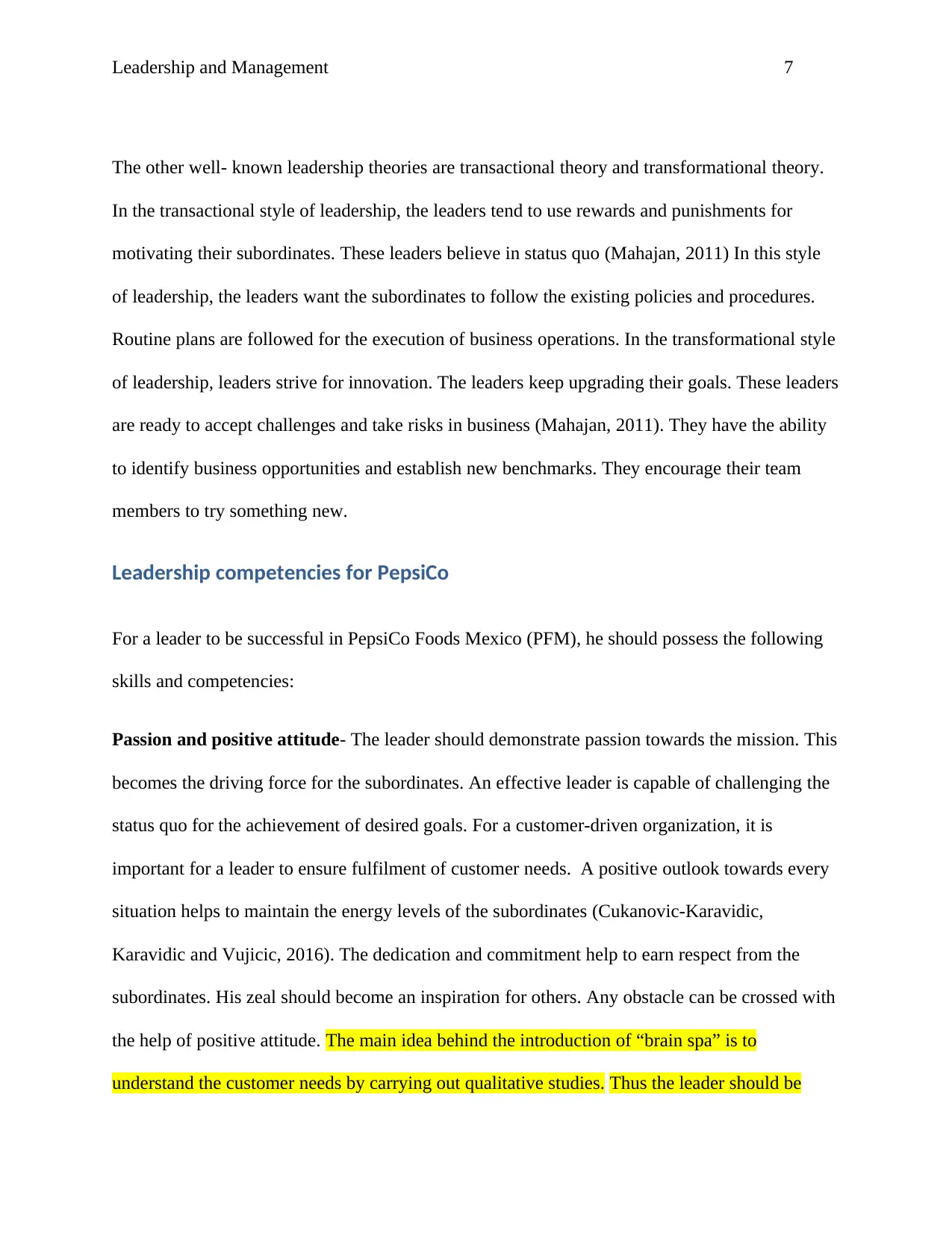
Leadership and Management 7
The other well- known leadership theories are transactional theory and transformational theory.
In the transactional style of leadership, the leaders tend to use rewards and punishments for
motivating their subordinates. These leaders believe in status quo (Mahajan, 2011) In this style
of leadership, the leaders want the subordinates to follow the existing policies and procedures.
Routine plans are followed for the execution of business operations. In the transformational style
of leadership, leaders strive for innovation. The leaders keep upgrading their goals. These leaders
are ready to accept challenges and take risks in business (Mahajan, 2011). They have the ability
to identify business opportunities and establish new benchmarks. They encourage their team
members to try something new.
Leadership competencies for PepsiCo
For a leader to be successful in PepsiCo Foods Mexico (PFM), he should possess the following
skills and competencies:
Passion and positive attitude- The leader should demonstrate passion towards the mission. This
becomes the driving force for the subordinates. An effective leader is capable of challenging the
status quo for the achievement of desired goals. For a customer-driven organization, it is
important for a leader to ensure fulfilment of customer needs. A positive outlook towards every
situation helps to maintain the energy levels of the subordinates (Cukanovic-Karavidic,
Karavidic and Vujicic, 2016). The dedication and commitment help to earn respect from the
subordinates. His zeal should become an inspiration for others. Any obstacle can be crossed with
the help of positive attitude. The main idea behind the introduction of “brain spa” is to
understand the customer needs by carrying out qualitative studies. Thus the leader should be
The other well- known leadership theories are transactional theory and transformational theory.
In the transactional style of leadership, the leaders tend to use rewards and punishments for
motivating their subordinates. These leaders believe in status quo (Mahajan, 2011) In this style
of leadership, the leaders want the subordinates to follow the existing policies and procedures.
Routine plans are followed for the execution of business operations. In the transformational style
of leadership, leaders strive for innovation. The leaders keep upgrading their goals. These leaders
are ready to accept challenges and take risks in business (Mahajan, 2011). They have the ability
to identify business opportunities and establish new benchmarks. They encourage their team
members to try something new.
Leadership competencies for PepsiCo
For a leader to be successful in PepsiCo Foods Mexico (PFM), he should possess the following
skills and competencies:
Passion and positive attitude- The leader should demonstrate passion towards the mission. This
becomes the driving force for the subordinates. An effective leader is capable of challenging the
status quo for the achievement of desired goals. For a customer-driven organization, it is
important for a leader to ensure fulfilment of customer needs. A positive outlook towards every
situation helps to maintain the energy levels of the subordinates (Cukanovic-Karavidic,
Karavidic and Vujicic, 2016). The dedication and commitment help to earn respect from the
subordinates. His zeal should become an inspiration for others. Any obstacle can be crossed with
the help of positive attitude. The main idea behind the introduction of “brain spa” is to
understand the customer needs by carrying out qualitative studies. Thus the leader should be
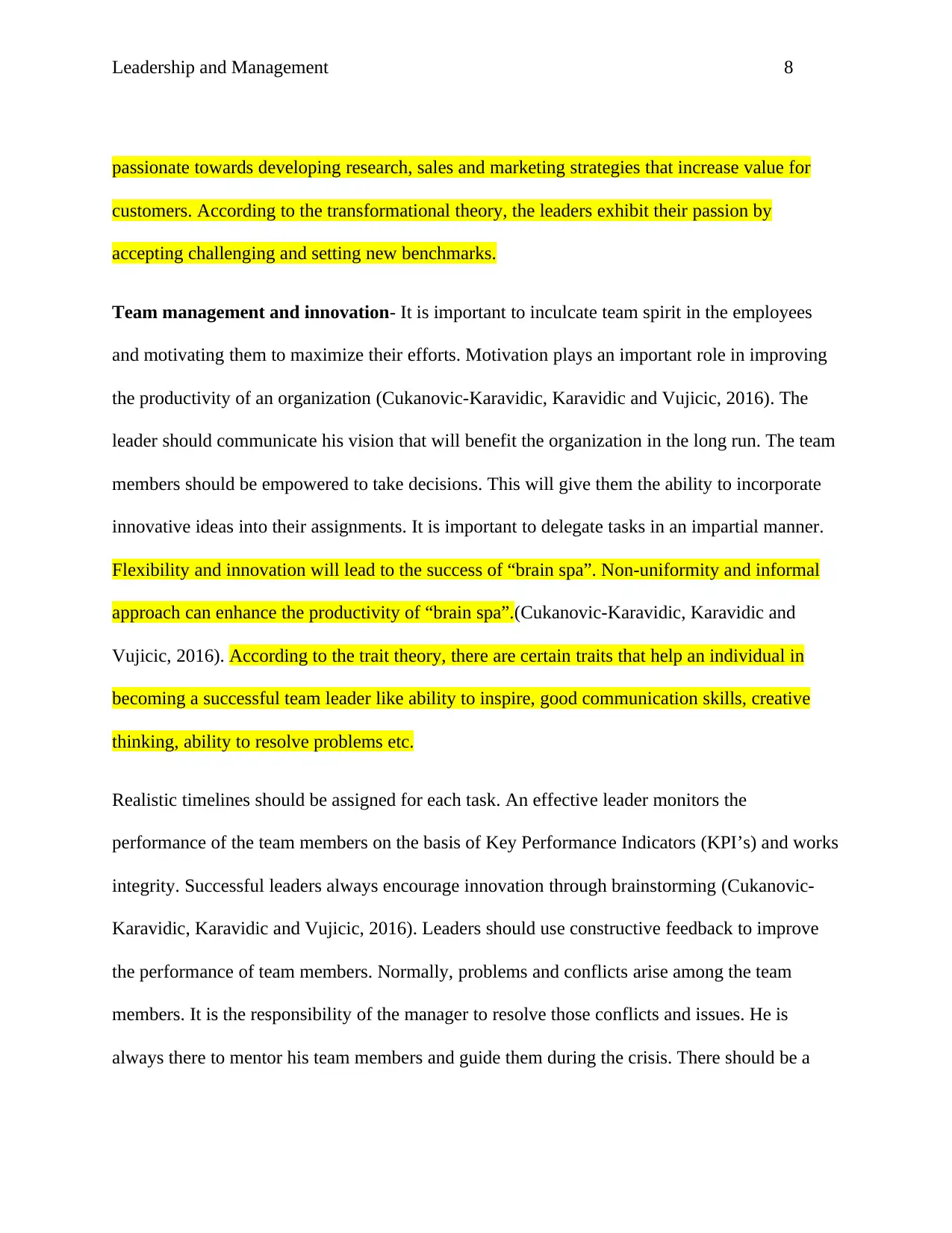
Leadership and Management 8
passionate towards developing research, sales and marketing strategies that increase value for
customers. According to the transformational theory, the leaders exhibit their passion by
accepting challenging and setting new benchmarks.
Team management and innovation- It is important to inculcate team spirit in the employees
and motivating them to maximize their efforts. Motivation plays an important role in improving
the productivity of an organization (Cukanovic-Karavidic, Karavidic and Vujicic, 2016). The
leader should communicate his vision that will benefit the organization in the long run. The team
members should be empowered to take decisions. This will give them the ability to incorporate
innovative ideas into their assignments. It is important to delegate tasks in an impartial manner.
Flexibility and innovation will lead to the success of “brain spa”. Non-uniformity and informal
approach can enhance the productivity of “brain spa”.(Cukanovic-Karavidic, Karavidic and
Vujicic, 2016). According to the trait theory, there are certain traits that help an individual in
becoming a successful team leader like ability to inspire, good communication skills, creative
thinking, ability to resolve problems etc.
Realistic timelines should be assigned for each task. An effective leader monitors the
performance of the team members on the basis of Key Performance Indicators (KPI’s) and works
integrity. Successful leaders always encourage innovation through brainstorming (Cukanovic-
Karavidic, Karavidic and Vujicic, 2016). Leaders should use constructive feedback to improve
the performance of team members. Normally, problems and conflicts arise among the team
members. It is the responsibility of the manager to resolve those conflicts and issues. He is
always there to mentor his team members and guide them during the crisis. There should be a
passionate towards developing research, sales and marketing strategies that increase value for
customers. According to the transformational theory, the leaders exhibit their passion by
accepting challenging and setting new benchmarks.
Team management and innovation- It is important to inculcate team spirit in the employees
and motivating them to maximize their efforts. Motivation plays an important role in improving
the productivity of an organization (Cukanovic-Karavidic, Karavidic and Vujicic, 2016). The
leader should communicate his vision that will benefit the organization in the long run. The team
members should be empowered to take decisions. This will give them the ability to incorporate
innovative ideas into their assignments. It is important to delegate tasks in an impartial manner.
Flexibility and innovation will lead to the success of “brain spa”. Non-uniformity and informal
approach can enhance the productivity of “brain spa”.(Cukanovic-Karavidic, Karavidic and
Vujicic, 2016). According to the trait theory, there are certain traits that help an individual in
becoming a successful team leader like ability to inspire, good communication skills, creative
thinking, ability to resolve problems etc.
Realistic timelines should be assigned for each task. An effective leader monitors the
performance of the team members on the basis of Key Performance Indicators (KPI’s) and works
integrity. Successful leaders always encourage innovation through brainstorming (Cukanovic-
Karavidic, Karavidic and Vujicic, 2016). Leaders should use constructive feedback to improve
the performance of team members. Normally, problems and conflicts arise among the team
members. It is the responsibility of the manager to resolve those conflicts and issues. He is
always there to mentor his team members and guide them during the crisis. There should be a
⊘ This is a preview!⊘
Do you want full access?
Subscribe today to unlock all pages.

Trusted by 1+ million students worldwide
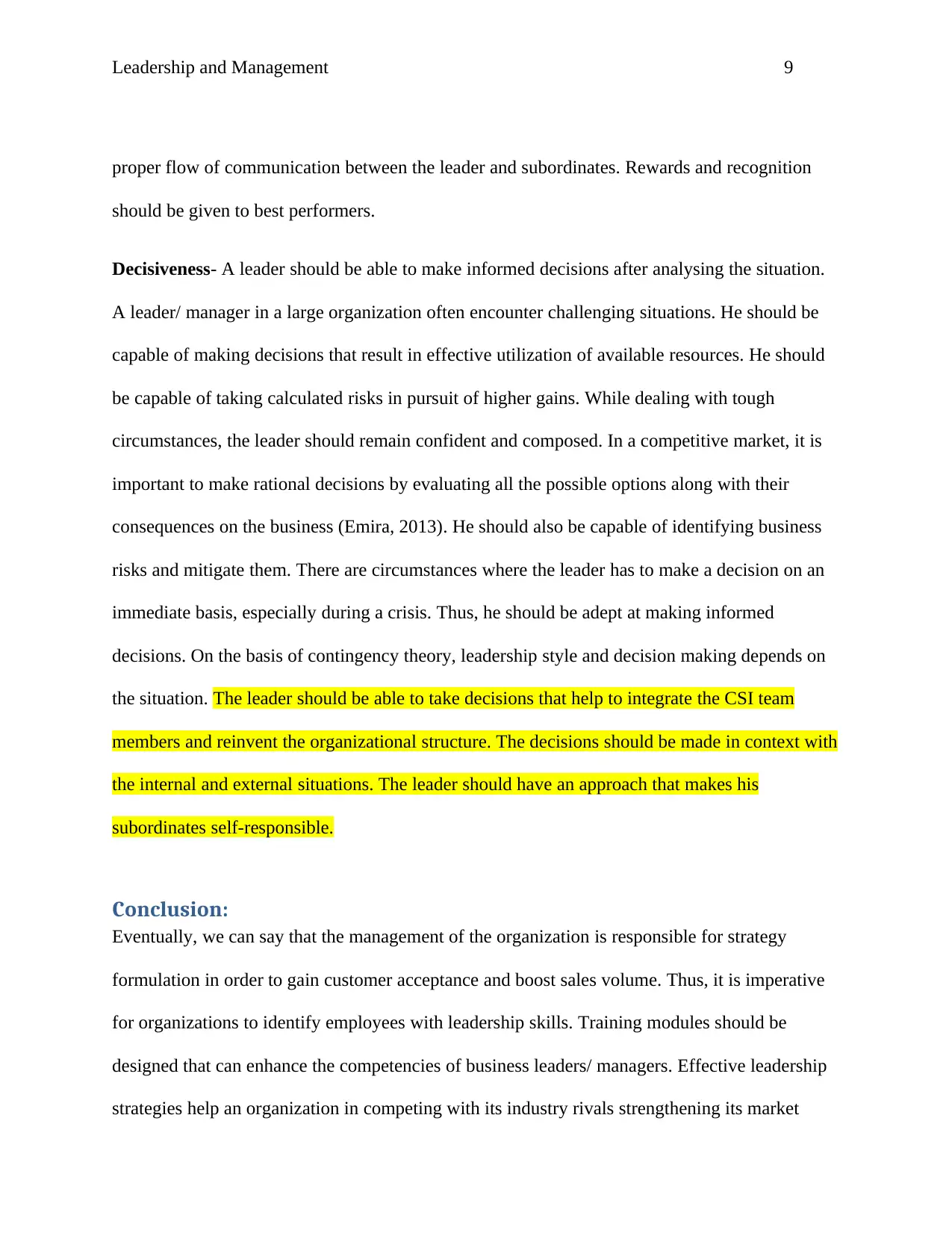
Leadership and Management 9
proper flow of communication between the leader and subordinates. Rewards and recognition
should be given to best performers.
Decisiveness- A leader should be able to make informed decisions after analysing the situation.
A leader/ manager in a large organization often encounter challenging situations. He should be
capable of making decisions that result in effective utilization of available resources. He should
be capable of taking calculated risks in pursuit of higher gains. While dealing with tough
circumstances, the leader should remain confident and composed. In a competitive market, it is
important to make rational decisions by evaluating all the possible options along with their
consequences on the business (Emira, 2013). He should also be capable of identifying business
risks and mitigate them. There are circumstances where the leader has to make a decision on an
immediate basis, especially during a crisis. Thus, he should be adept at making informed
decisions. On the basis of contingency theory, leadership style and decision making depends on
the situation. The leader should be able to take decisions that help to integrate the CSI team
members and reinvent the organizational structure. The decisions should be made in context with
the internal and external situations. The leader should have an approach that makes his
subordinates self-responsible.
Conclusion:
Eventually, we can say that the management of the organization is responsible for strategy
formulation in order to gain customer acceptance and boost sales volume. Thus, it is imperative
for organizations to identify employees with leadership skills. Training modules should be
designed that can enhance the competencies of business leaders/ managers. Effective leadership
strategies help an organization in competing with its industry rivals strengthening its market
proper flow of communication between the leader and subordinates. Rewards and recognition
should be given to best performers.
Decisiveness- A leader should be able to make informed decisions after analysing the situation.
A leader/ manager in a large organization often encounter challenging situations. He should be
capable of making decisions that result in effective utilization of available resources. He should
be capable of taking calculated risks in pursuit of higher gains. While dealing with tough
circumstances, the leader should remain confident and composed. In a competitive market, it is
important to make rational decisions by evaluating all the possible options along with their
consequences on the business (Emira, 2013). He should also be capable of identifying business
risks and mitigate them. There are circumstances where the leader has to make a decision on an
immediate basis, especially during a crisis. Thus, he should be adept at making informed
decisions. On the basis of contingency theory, leadership style and decision making depends on
the situation. The leader should be able to take decisions that help to integrate the CSI team
members and reinvent the organizational structure. The decisions should be made in context with
the internal and external situations. The leader should have an approach that makes his
subordinates self-responsible.
Conclusion:
Eventually, we can say that the management of the organization is responsible for strategy
formulation in order to gain customer acceptance and boost sales volume. Thus, it is imperative
for organizations to identify employees with leadership skills. Training modules should be
designed that can enhance the competencies of business leaders/ managers. Effective leadership
strategies help an organization in competing with its industry rivals strengthening its market
Paraphrase This Document
Need a fresh take? Get an instant paraphrase of this document with our AI Paraphraser
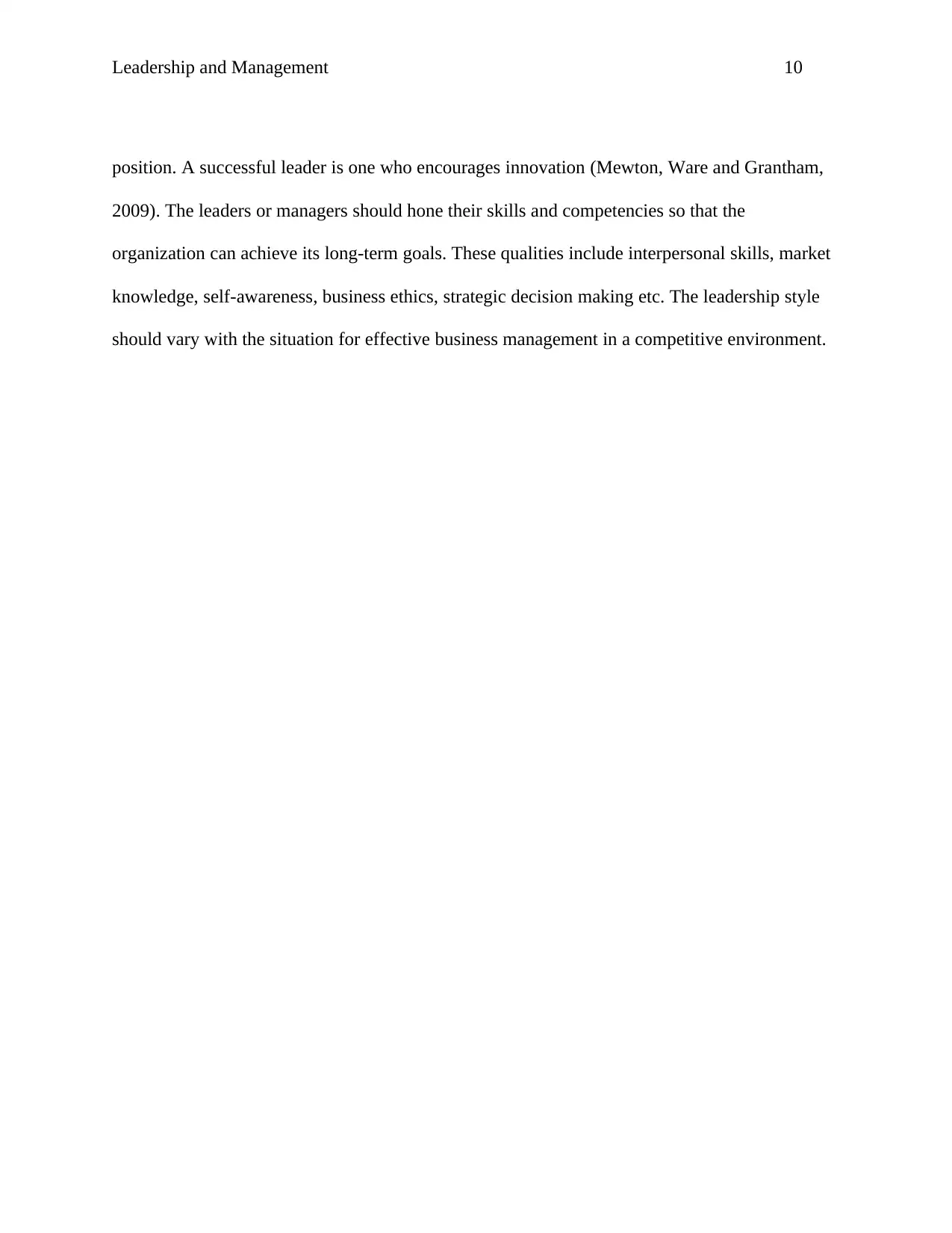
Leadership and Management 10
position. A successful leader is one who encourages innovation (Mewton, Ware and Grantham,
2009). The leaders or managers should hone their skills and competencies so that the
organization can achieve its long-term goals. These qualities include interpersonal skills, market
knowledge, self-awareness, business ethics, strategic decision making etc. The leadership style
should vary with the situation for effective business management in a competitive environment.
position. A successful leader is one who encourages innovation (Mewton, Ware and Grantham,
2009). The leaders or managers should hone their skills and competencies so that the
organization can achieve its long-term goals. These qualities include interpersonal skills, market
knowledge, self-awareness, business ethics, strategic decision making etc. The leadership style
should vary with the situation for effective business management in a competitive environment.
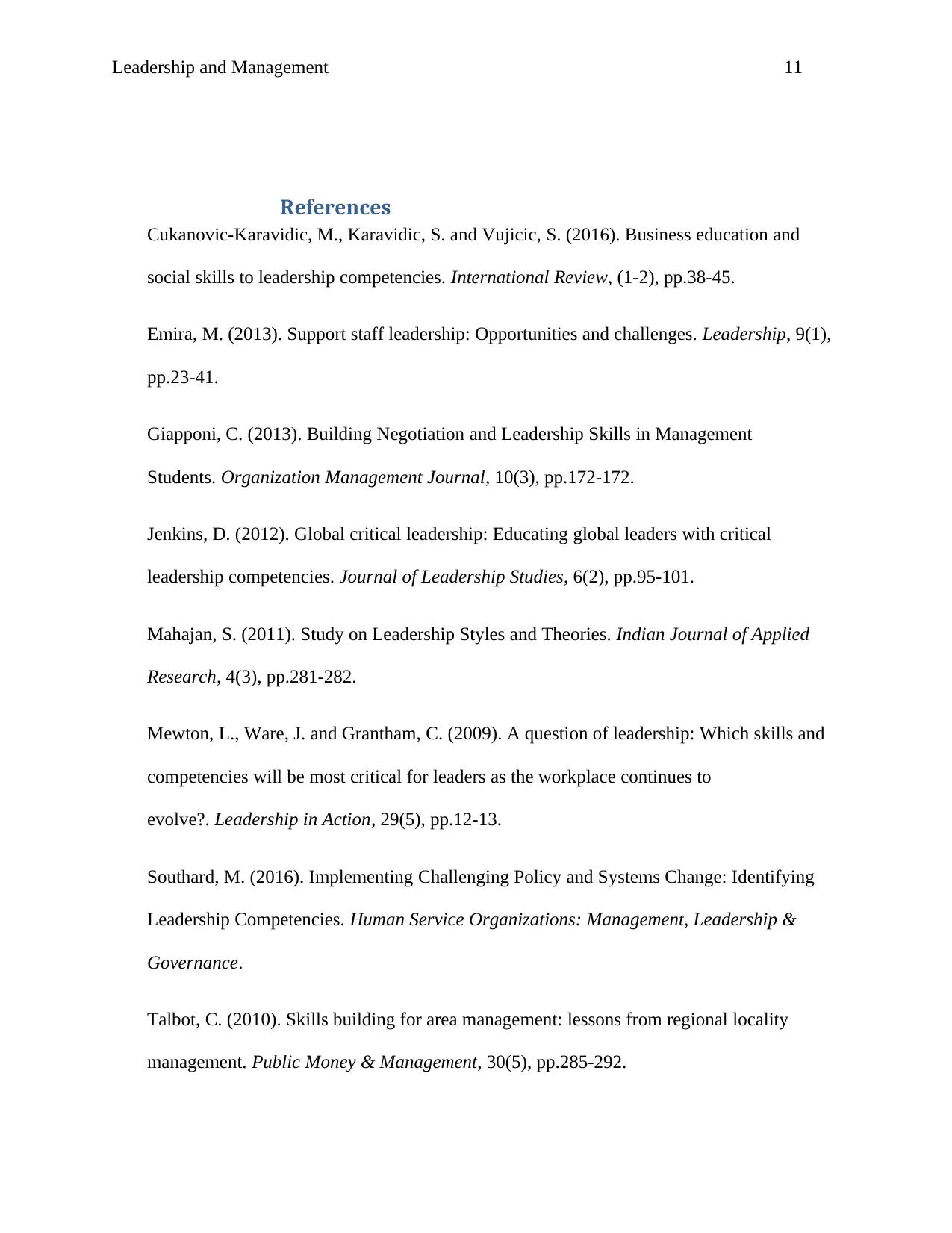
Leadership and Management 11
References
Cukanovic-Karavidic, M., Karavidic, S. and Vujicic, S. (2016). Business education and
social skills to leadership competencies. International Review, (1-2), pp.38-45.
Emira, M. (2013). Support staff leadership: Opportunities and challenges. Leadership, 9(1),
pp.23-41.
Giapponi, C. (2013). Building Negotiation and Leadership Skills in Management
Students. Organization Management Journal, 10(3), pp.172-172.
Jenkins, D. (2012). Global critical leadership: Educating global leaders with critical
leadership competencies. Journal of Leadership Studies, 6(2), pp.95-101.
Mahajan, S. (2011). Study on Leadership Styles and Theories. Indian Journal of Applied
Research, 4(3), pp.281-282.
Mewton, L., Ware, J. and Grantham, C. (2009). A question of leadership: Which skills and
competencies will be most critical for leaders as the workplace continues to
evolve?. Leadership in Action, 29(5), pp.12-13.
Southard, M. (2016). Implementing Challenging Policy and Systems Change: Identifying
Leadership Competencies. Human Service Organizations: Management, Leadership &
Governance.
Talbot, C. (2010). Skills building for area management: lessons from regional locality
management. Public Money & Management, 30(5), pp.285-292.
References
Cukanovic-Karavidic, M., Karavidic, S. and Vujicic, S. (2016). Business education and
social skills to leadership competencies. International Review, (1-2), pp.38-45.
Emira, M. (2013). Support staff leadership: Opportunities and challenges. Leadership, 9(1),
pp.23-41.
Giapponi, C. (2013). Building Negotiation and Leadership Skills in Management
Students. Organization Management Journal, 10(3), pp.172-172.
Jenkins, D. (2012). Global critical leadership: Educating global leaders with critical
leadership competencies. Journal of Leadership Studies, 6(2), pp.95-101.
Mahajan, S. (2011). Study on Leadership Styles and Theories. Indian Journal of Applied
Research, 4(3), pp.281-282.
Mewton, L., Ware, J. and Grantham, C. (2009). A question of leadership: Which skills and
competencies will be most critical for leaders as the workplace continues to
evolve?. Leadership in Action, 29(5), pp.12-13.
Southard, M. (2016). Implementing Challenging Policy and Systems Change: Identifying
Leadership Competencies. Human Service Organizations: Management, Leadership &
Governance.
Talbot, C. (2010). Skills building for area management: lessons from regional locality
management. Public Money & Management, 30(5), pp.285-292.
⊘ This is a preview!⊘
Do you want full access?
Subscribe today to unlock all pages.

Trusted by 1+ million students worldwide
1 out of 13
Related Documents
Your All-in-One AI-Powered Toolkit for Academic Success.
+13062052269
info@desklib.com
Available 24*7 on WhatsApp / Email
![[object Object]](/_next/static/media/star-bottom.7253800d.svg)
Unlock your academic potential
Copyright © 2020–2025 A2Z Services. All Rights Reserved. Developed and managed by ZUCOL.




